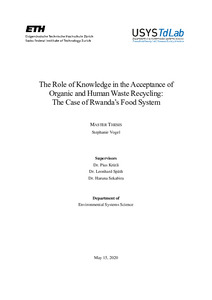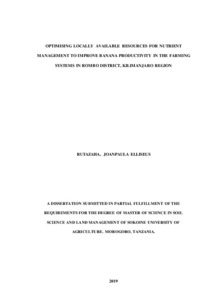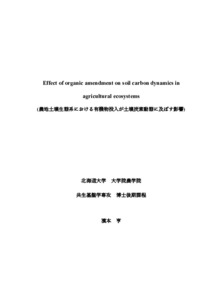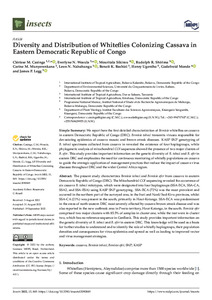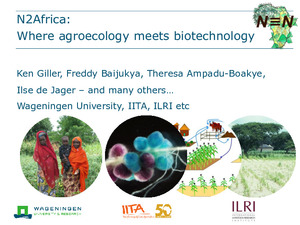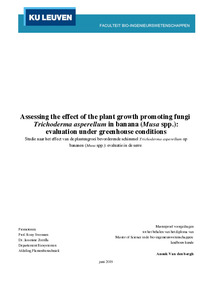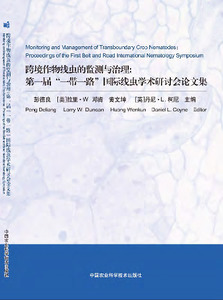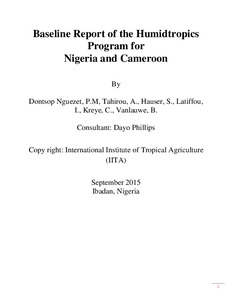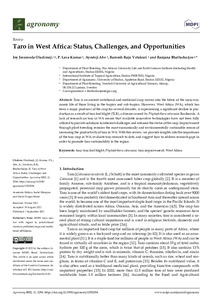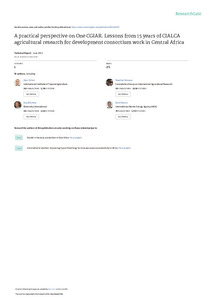Welcome to the International Institute of Tropical Agriculture Research Repository
IITA Bibliography System: Recent submissions
Now showing items 801-820 of 8099
-
The role of knowledge in the acceptance of organic and human waste recycling: the case of Rwanda's food system
(Swiss Federal Institute of Technology, 2020-05-15)By 2050, the world’s population is expected to increase to 9 billion people. The growing population intensifies urbanization, which puts pressure on the current challenges of food insecurity and environmental pollution. In Rwanda, rural migration and the lack of financial capital to apply sufficient fertilizer result in nutrient-deficient agricultural soils which lead to a decrease in food production. Moreover, the rapid urban expansion leads to environmental pollution and human health risks from ... -
Effect of soil conservation on productivity and food security on maize farmers in northwest Nigeria
(Ahmadu Bello University, 2019-09)The adoption of soil conservation practices is important for sustaining Nigerian agriculture where smallholder maize farmers face constraints such as low soil fertility that lead to low productivity and food insecurity. This study aims to analyze the effect of soil conservation on productivity and food security of maize farmers in Northwest Nigeria. The study used a two year panel data of 792 maize farmers for 2016 and 2017 cropping seasons, collected by IITA under “Taking Maize Agronomy to Scale ... -
Optimising locally available resources for nutrient management to improve banana productivity in the farming systems in Rombo District, Kilimanjaro region
(Sokoine University of Agriculture, 2019)Banana is an important staple food in East Africa and an essential cash crop in the national and local economies. In Kagera and Kilimanjaro regions of Tanzania, banana is cultivated by more than 70% of smallholder farmers as a staple food in home gardens ranging from 0.5 to 2 hectares. Decline in banana yield has been reported in banana farming systems as a result of abiotic constraints (nutrient deficiencies and drought stress) and biotic constraints (pests and diseases). Decline in soil fertility ... -
Socio economic and botanic analysis of West Bank and Block A Forest of International Institute of Tropical Agriculture (IITA), Ibadan, Oyo State, Nigeria
(Federal University of Agriculture, Abeokuta, 2018-09)Forests are community of plants (vegetation) dominated by trees and are crucial to the welfare of man. Socio- economic and botanic analysis of West Bank and Block A Forests of International Institute of Tropical Agriculture (IITA) was undertaken with the aim of determining the uses, structure, composition, similarity, extent of diversity of the forests, types and quantity of non- timber forest products (NTFPs) collected from the forests. The determinants of medicinal plants usage and intensity ... -
Effect of organic amendment on soil carbon dynamics in agricultural ecosystems
(Hokkaido University, 2020-03-25)Soil carbon (C) contents and dynamics are important in the maintenance of health soils. Organic amendments (e.g. crop residue and organic manure) are known as materials to increase soil C. The degradation of organic amendments and physical disturbance of soils, performed by the fauna, can alter soil microbial community, and thus influence rates of the C cycles. However, little is known about the interaction between different soil biological communities (i.e. soil fauna and microbes) regarding soil ... -
Equal and inclusive opportunity to access and use of ICT-based crop extension services for farm-level actors in Rwanda: a case study of the ICT4BXW project
(Wageningen University and Research Center, 2020-03-31)All farmers around the world have a need for information. Information communication technology (ICT) could make access to information easier (Palumbo, 2013) (Aker & Mbiti, 2010) (van Winden, 2011). Others do however claim that the use of ICT excludes certain users from accessing information (Diga, Fortune, & Plantinga, 2013) (Njoki & Wabwoba, 2014) (Waugaman, 2016). Not only the use of ICT but also the design of the ICT platform could exclude users from access to information (Clarkson, Dong, & ... -
Diversity and distribution of whiteflies colonizing cassava in eastern Democratic Republic of Congo
(2022)The present study characterizes Bemisia tabaci and Bemisia afer from cassava in eastern Democratic Republic of Congo (DRC). The Mitochondrial COI sequencing revealed the occurrence of six cassava B. tabaci mitotypes, which were designated into four haplogroups (SSA-ECA, SSA-CA, SSA2, and SSA-ESA) using KASP SNP genotyping. SSA-ECA (72%) was the most prevalent and occurred in the northern part of the surveyed area, in the Ituri and Nord/Sud-Kivu provinces, whilst SSA-CA (21%) was present in the ... -
N2Africa: where agroecology meets biotechnology
(N2Africa, 2020) -
Nematode biodiversity in south-western Nigerian watermelon cropping systems, with reference to Meloidogyne and its management
(North-West University, 2020-05)Watermelon is increasingly produced and consumed in Nigeria and sub-Saharan Africa (SSA). However, limited information exists regarding the nematode fauna associated with the crop. Therefore, the overall aim of this study was to determine the nematode assemblages associated with watermelon, to investigate the reproduction potential of populations of the predominant plant-parasitic nematodes identified and to assess the host status of commercially available cultivars in south-west Nigeria to the ... -
Site-specific nutrient management advice and agricultural intensification in maize-based systems in Nigeria
(Katholieke Universiteit Leuven, 2019-12)Despite the potentially large gains from intensification and agricultural productivity growth in Sub-Saharan Africa (SSA), yields of staple crops, such as maize are far below attainable yields. Depletion of soil fertility associated with low and inappropriate use of nutrients play a crucial role in this. Yet, fertilizer use is low in SSA, which partly relates to information constraints. Relaxing such constraints via agricultural extension interventions is expected to produce positive outcomes but ... -
Assessing the effect of the plant growth promoting fungi Trichoderma asperellum in banana (Musa spp.): evaluation under greenhouse conditions
(Katholieke Universiteit Leuven, 2019-06)Bananas (Musa spp.) are one of the most important crops in the global food crop industry, the second most important fruit crop and an important staple crop around the world. Due to the increased trend in global population, a raise in the intensity in crop productivity is needed. The use of plant growth-promoting microorganisms (PGPM) could be an alternative to improve the stress-tolerance and productivity of crops, thus, reducing the amount of chemical pesticides and fertilizers needed. Trichoderma ... -
Monitoring and management of transboundary crop nematodes: proceedings of the First Belt and Road International Nematology Symposium
(Chinese Academy of Agricultural Sciences, 2020) -
Estimating the impact of COVID-19 on small and medium scale enterprise: evidence from Nigeria.
(2020)This paper examines the effect of COVID-19 related cases and lockdown measures on the issues related to Small and Medium Scale Enterprise in Nigeria. Using an electronic data collection approach, this study analyzes the data using the linear probability model to estimate the effect of the pandemic on the entrepreneurs and model the factors influencing coping strategies using a multivariate probit model. We found that majority of the entrepreneurs have been affected (both severely and slightly) by ... -
Baseline report of the humidtropics program for Nigeria and Cameroon
(International Institute of Tropical Agriculture, 2015) -
The role of plant health in mitigating economic losses caused by the COVID-19 pandemic
(International Institute of Tropical Agriculture, 2020) -
Adaptation strategies to climate change and impacts on household income and food security: evidence from Sahelian region of Niger
(2022-03-01)Sahelian countries, particularly Niger, are more vulnerable to climate change due to the high dependence of most of their populations on rain-fed agriculture and limited capacities to respond to climate variability and change. This paper examines the factors influencing climate change adaptation strategies and the impacts on household income and food security in rural Niger. For this purpose, we collected data from 1783 valid rural households in four main agricultural regions of Niger. The results ... -
Strategizing research and development investments in climate change adaptation for root, tuber and banana crops in the African Great Lakes Region: a spatial prioritisation and targeting framework
(2022-10-22)CONTEXT Given the significance of climate change impacts on farming communities, large investments are made by research and development actors, including farmers themselves, to adapt agricultural systems. A data-driven approach is required to guide these investments and maximize their impact. In the African Great Lakes Region (GLR), root, tuber and banana (RT&B) crops are a vital component of smallholder farming systems, but little is known about strategies to mitigate climate change impacts on ... -
Taro in west Africa: status, challenges, and opportunities
(2022-09-01)Taro is an ancient nutritional and medicinal crop woven into the fabric of the socio-economic life of those living in the tropics and sub-tropics. However, West Africa (WA), which has been a major producer of the crop for several decades, is experiencing a significant decline in production as a result of taro leaf blight (TLB), a disease caused by Phytophthora colocasiae Raciborski. A lack of research on taro in WA means that available innovative technologies have not been fully utilized to provide ... -
A practical perspective on One CGIAR. Lessons from 15 years of CIALCA agricultural research for development consortium work in Central Africa
(2021-06)This perspective paper complements the Special Issue, by taking the five Challenges and Recommendations to One CGIAR as a starting point, and grounds those recommendations in the 15 years of AR4D practice of the Consortium for Improving Agriculture-based Livelihoods in Central Africa (CIALCA). CIALCA is a longstanding consortium of CGIAR centres and regional and national research and development partners that aims to accelerate the impact of agricultural research for sustainable development and ...


